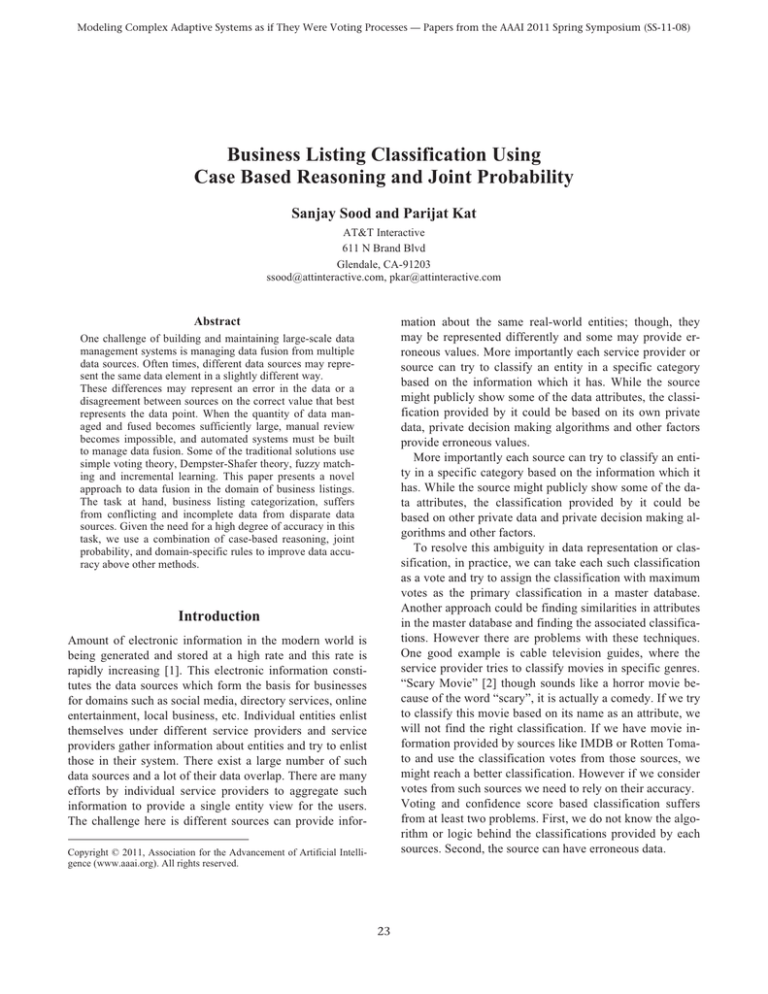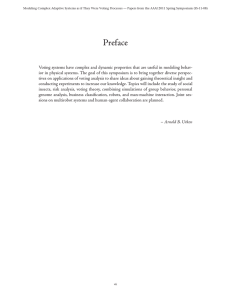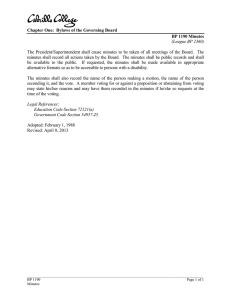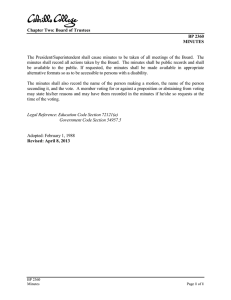
Modeling Complex Adaptive Systems as if They Were Voting Processes — Papers from the AAAI 2011 Spring Symposium (SS-11-08)
Business Listing Classification Using
Case Based Reasoning and Joint Probability
Sanjay Sood and Parijat Kat
AT&T Interactive
611 N Brand Blvd
Glendale, CA-91203
ssood@attinteractive.com, pkar@attinteractive.com
mation about the same real-world entities; though, they
may be represented differently and some may provide erroneous values. More importantly each service provider or
source can try to classify an entity in a specific category
based on the information which it has. While the source
might publicly show some of the data attributes, the classification provided by it could be based on its own private
data, private decision making algorithms and other factors
provide erroneous values.
More importantly each source can try to classify an entity in a specific category based on the information which it
has. While the source might publicly show some of the data attributes, the classification provided by it could be
based on other private data and private decision making algorithms and other factors.
To resolve this ambiguity in data representation or classification, in practice, we can take each such classification
as a vote and try to assign the classification with maximum
votes as the primary classification in a master database.
Another approach could be finding similarities in attributes
in the master database and finding the associated classifications. However there are problems with these techniques.
One good example is cable television guides, where the
service provider tries to classify movies in specific genres.
“Scary Movie” [2] though sounds like a horror movie because of the word “scary”, it is actually a comedy. If we try
to classify this movie based on its name as an attribute, we
will not find the right classification. If we have movie information provided by sources like IMDB or Rotten Tomato and use the classification votes from those sources, we
might reach a better classification. However if we consider
votes from such sources we need to rely on their accuracy.
Voting and confidence score based classification suffers
from at least two problems. First, we do not know the algorithm or logic behind the classifications provided by each
sources. Second, the source can have erroneous data.
Abstract
One challenge of building and maintaining large-scale data
management systems is managing data fusion from multiple
data sources. Often times, different data sources may represent the same data element in a slightly different way.
These differences may represent an error in the data or a
disagreement between sources on the correct value that best
represents the data point. When the quantity of data managed and fused becomes sufficiently large, manual review
becomes impossible, and automated systems must be built
to manage data fusion. Some of the traditional solutions use
simple voting theory, Dempster-Shafer theory, fuzzy matching and incremental learning. This paper presents a novel
approach to data fusion in the domain of business listings.
The task at hand, business listing categorization, suffers
from conflicting and incomplete data from disparate data
sources. Given the need for a high degree of accuracy in this
task, we use a combination of case-based reasoning, joint
probability, and domain-specific rules to improve data accuracy above other methods.
Introduction
Amount of electronic information in the modern world is
being generated and stored at a high rate and this rate is
rapidly increasing [1]. This electronic information constitutes the data sources which form the basis for businesses
for domains such as social media, directory services, online
entertainment, local business, etc. Individual entities enlist
themselves under different service providers and service
providers gather information about entities and try to enlist
those in their system. There exist a large number of such
data sources and a lot of their data overlap. There are many
efforts by individual service providers to aggregate such
information to provide a single entity view for the users.
The challenge here is different sources can provide inforCopyright © 2011, Association for the Advancement of Artificial Intelligence (www.aaai.org). All rights reserved.
23
Another approach of supervised learning [3] is difficult for
such problem space because the data volume is too large
and it is difficult to find a limited set of training data. The
number of categories in a taxonomy tree could have more
than 5000 categories and if the training set does not have
enough sample data from each category, the classification
does not find enough examples to reach a classification or
leads to an erroneous classification.
However we have found that a similarity based classification using a technique like Naïve-Bayes[4] classifier and
using a joint probability[5] based in combination to that
improves the result significantly.
Master Object id: 10000
Source: XYZ Confidence Score: 0.6
Attribute
Value
Name
Subway Cleaners
Aka
Subway Cleaners Inc
Phone
626-232-8059
Address
Chino Hills, CA
Primary Classification
Restaurant
Other Classifications
Cleaning Contractor
Master Object id: 20000
Source: XYZ Confidence Score: 0.4
Attribute
Value
Name
Sub Cleaners
Aka
Not Available
Phone
909-301-0121
Address
Chino, CA
Primary Classification
Dry cleaners
Other Classifications
Contractor
Problem Definition
Master object set, be a set of real-world objects in the
same domain such as business listing and directory entries.
Each object is described by a set of attributes, and each object contains one or many values for each attribute. For example in the business listing domain, every listing has
name, aka names, phone, address, reviews and ratings.
Some of these attributes could be empty or unavailable.
is a set of data sources, each source having an element
attribute format. Each source has a unique identifier as the
source name and source code. For each object in, a
source can provide a set of records with a set of
utes, which may contain different values of a single attribute , or different representations of the same value
in . Some of the values may not conform to certain data
constraints and are subject to cleaning. Individual sources
may have repetition of the same attributes. We clean such
records and convert all the source records in the similar element-attribute relationship. Each data source also suggests a set of classifications for the objects in. The classification could be of two types; “primary classification”,
and possible “other classification”,. Hence, is a
composition of, and.
Let’s take an example we have a business listing with a source with unique source code “XYZ”.
Some examples of the attributes in are business name,
aka (also known as) name, phone number, address, reviews
and ratings. We also get a set of classification for from. However we do not know the rationale behind
classifying in category, where The
source “XYZ” has its own algorithm and other data
sources to determine such a classification. In the Table 1
we show such a record.
Every source based on a general analysis has a confidence score. This score is a probability of the source being
correct. Some of the sources are more reliable and some
are less and some sources could be sacrosanct and could
not be overridden because that has been manually reviewed.
Table 1
Master Object id: 10000
Primary Category
Category Description
Cleaning Contractor
Source
XYZ
Score
90
Other possible Categories
Category Description
Source
Score
Dry Cleaners
65
ABC
Table 2
Algorithm
In this paper we discuss a new algorithm: given a set of
independent data sources, and a taxonomy tree, try to associate a set of primary category, and a set of
permissible other categories . Sample final results
are in Table 2.
Taxonomy tree is a tree structure of classifications for
a given set of objects. At the top of this structure is a single
classification, the root node that applies to all objects.
Nodes below this root are more specific classifications that
apply to subsets of the total set of classified objects. Each
node in the taxonomy tree represents a category and that
has a set of keywords. For example the keywords associated with the node for category “restaurant” are “food, restaurant, cuisine, spice, taste”. A sample taxonomy tree is
shown in Figure 1.
24
avg = average(f);
F* is a list of categories f*[0] to f*[n];
for (all categories in F)
if (f[i] > avg)
add f[i] to F*;
end for
cat_clusters = createCategoryClusters (f*);
Table H is a map of categories and scores;
for (all s[i] in S)
sim = 0;
for (all a[i] in all attributes)
K = getKeywords(s[i]);
sim = sim + similarity (a[i], K);
end for;
confidence_score = getConfideneceScore(s[i]);
if (s[i] in cat_cluster)
confidence_score = confidence_score * GAMMA;
score = sim * confidence_score;
Put <category, score> in Table H;
end for;
Figure 1
We compute a total classification score for the object by
summing up similarity of attributes with the suggested category multiplied by the confidence score for that particular
source. In other words, we compute the probability of a
category suggested by a source to be true given the probability the source to be true and the probability of attributes
provided by the source to be true. If we have source suggesting category for object , we compute similarity between attributes of obtained from with the keywords for as where, .
If the confidence score for the source , is the
probability of the source to be true, by the theory of
joint probability we can say that the category suggested
by the source to be true is . Hence
by the theory of total probability we can say that the probability of the object to be in the category is
sort table H on the highest score;
return the category with the highest score;
end function;
createCategoryClusters (List of Categories F) returns a
cluster of categories
C is an empty list of category clusters;
for (f[i] in F)
boolean createNew = true;
c = create a new cluster with the first element in F;
for (f*[j] in F)
if (isSimilar(f*[j], f[i]))
add f*[j] to c;
createNew = false;
break;
end if
end for
if (createNew)
c= create a new cluster with first element as f[i];
add c to C;
end if
end for
return C;
end of function;
Similarity of attribute values to category keywords. In
the domain of business listing most of the attributes are
String variables and we try to find the similarity of an attribute with. Similarity in String attributes are determined
using TF-IDF [6] algorithms.
In Figure 2a we describe the joint probability based algorithm. The simple voting algorithm is listed in Figure
2b.
getPrimaryCategory (Sources S, Master Object m,
TaxonomyTree T) returns a category
F is a list of categories f[0] to f[n];
for (all attributes a[i] in A)
for (all categories c[j] in T)
f[i] = frequencies of different categories with
similar attributes a
end for
end for
isSimilar(category1, category2) returns Boolean
k1 = keywords from category1;
k2 = keywords from category2;
25
tities to have categories which are less acceptable than voting or Naïve-Bayes classification algorithms. This shows a
significant improvement of result, considering 440 newly
available categories are correct out of 596 changes in the
categories, which a 73.8% accuracy on the changes and
8.8% on total number of listings. Figure 1 shows a comparison of the results from three algorithms. The Amazon
Mechanical Turk (MTurk)[7] is a crowd sourcing internet
market place that enables computer programmers to coordinate the use of human intelligence to perform tasks
which computers are unable to do. We also used MTurk to
verify some of these results and the MTurk agreed to more
than 90% of the new categories or has a overlapping result
which has more than one categories, which has the category generated from the joint probability algorithm.
The next set of experiment shows the changes in result
with availability of more attribute data are available. Primarily we compare results when more number of aka
names and reviews for the listings are available. The results from increasing number of attribute values shows that
the suggested algorithm works much with more number of
attributes available (Figure 3).
The third set of experiments tries to find the scalability of
the algorithm with more sources and more sources with incorrect classifications. We select a random category from
the Naïve-Bayes classifier and create a new source, having
the randomly selected category as the suggested category
by that source. In Figure 4 we show how the number of
classification accuracy changes with more source systems
and more noise. In this set of experiments the average
numbers of noise or bad category sources were about 10%.
Clearly we can see that both the voting algorithm and the
joint probability based algorithm scales to classify more
number of listings correctly when more number of source
systems is available and only 10% of them are bad. However as the joint probability based algorithm uses more
classifications from Naïve-Bayes classifier and computes
similarities of attributes with those additionally available
categories, the number of correct classifications are better
than the simple voting algorithm.
To add some noise to the source systems, we also select
some categories which are neither in Naïve-Bayes classifier, nor in the real sources. The objective is to find how the
joint probability based algorithm can filter noises. In Figure 5 we show how the algorithms scale when more noises
are added to the system. We see that the voting algorithm
fails sharply when noise is very high and greater than 40%.
While the accuracy from joint probability based algorithm
declines with more noise it could classify more than 5%
listings with more accuracy. More importantly when the
noise from source systems are less than 40%, which is a
noise level close to real life data sources, the joint probability algorithm has done more than 12% better classification than the voting algorithm. More excitingly if the noise
dist = taxonomical distance between category1
and category2;
if ((TFIDF(k1, k2) > BETA) and dist < D)
return true;
else
return false;
end function;
Figure 2a
getPrimaryCategyByVoting(Sources S, Master Object m,
TaxonomyTree T) returns a category
U = Unique sources(S);
C = set of all the categories in U
Table H is a map of categories and scores;
for (c in C)
Score[c]=sum of all the confidence scores from all the
available sources for c;
Put <category, score> in Table H;
end for;
sort table H on the highest score;
return the category with the highest score;
end function;
Figure 2b
Experimental Results
We have run several set of experiments with the proposed
algorithm comparing with other commonly available algorithms like voting and a simple Naïve-Bayes classifier. We
also studied the changes in result with varying number of
attribute and sources. The experiments are done with
commonly available business listing entities collected from
publicly available directory services like yelp.com,
yp.com, allbusiness.com, superpages.com and each considered as a source system. On the first set of experiments we
run 5000 business listings through a simple voting algorithm, Naïve-Bayes classifier and the proposed algorithm.
The average number of source for each listing is 4.23. Also
127 business listings have no source suggested categories.
Hence the voting algorithm cannot generate any primary or
probable category as there is no available vote. The simple
voting algorithm takes the category that occurs most number of times in all the sources for the given entity. We
found that 4281 primary categories remain the same in all
the three runs of the algorithms. The remaining 719 entities
have different classifications generated by the new algorithm. By manual reviews we found that the new algorithm
could not reach a conclusion based on insufficient or contradicting data in 123 entities. The 596 newly available
categories are manually reviewed and found 440 of those
to be more correct or better classification. We found 17 en-
26
Figure 3
Figure 5
As we go higher level on the taxonomy tree, we get more
generic categories. While this heuristics works in most of
the cases, it fails for the cases which demands for more
specific categories.
In a different ramification of the business listing efforts
can potentially use internet crawlers to search for independent data for a given name, address, phone numbers for
a less knows business. The searched information can include customer reviews and other critical information
which could be extracted using several data mining techniques and can further improve the business listing classifications. For example, if the reviews which are found on
internet search have too many keywords in the restaurant
category like food, cuisine, taste, serving etc., we can try to
associate the business to restaurant category.
Figure 4
increases from 10% to 20%, the accuracy from joint probability algorithm does not decline much where the voting
algorithm declines sharply.
Conclusion
This paper studies the problem of primary category detection in the presence different categories suggested by various sources and various attribute data presented by different sources. The key idea of our solution is to find the logic
and justification of a classification provided by a source by
finding similarities of such classifications with other available attributes from other sources and other suggested categories provided by other sources. We build clusters of
categories from different sources and try to match the cluster with other attributes and finally pick the best category
in top cluster. The experimental result studies show that
this approach increases significant accuracy and the approach could be further improved by adding more attributes and other factors.
Future Works
This work needs further exploration to see how increasing
more the number of attributes in the source sets affects the
result. Also we can explore how partially available data in
the attributes could be used for similarity computation. We
can also explore if some source system is an original
source of the data or it is duplicating information from another source. If we have duplicate data from various
sources, we will add additional voting factor to the computed category probabilities. There are several works to
find record linkage in data fusion [8].
The future works need also need to include a good strategy for tie-breaking. If the scores are same for more than
one category, we need to determine which will be a better
candidate for primary category. In the current system we
select the category which is a higher level on the taxonomy
tree.
References
[1] J. Aslam, K. Pelekhov, and D. Rus. 1999. A practical
clustering algorithm for static and dynamic information
organization. SODA.
27
[2] Hiemstra, D. 2000. A probabilistic justification for using tf.idf term weighting in information retrieval. International Journal on Digital Libraries
[3] Hui Han , Lee Giles , Hongyuan Zha , Cheng Li ,
Kostas Tsioutsiouliklis. 2004. Two supervised learning approaches for name disambiguation in author citations. In
IEEE joint conference on Digital libraries
[4] A. McCallum and K. Nigam. 1998. A comparison of
event models for naive bayes text classification. In AAAI
Workshop on Learning for Text Categorization.
[5] Marek J. Druzdzel. 1994. Some Properties of Joint
Probability Distributions. In Proceedings of the 10th Conference on Uncertainty in Artificial Intelligence.
[6] Ho Chung Wu. Interpreting TF-IDF term weights as
making relevance decisions. Journal ACM Transactions on
Information Systems (TOIS). Volume 26 Issue 3, June
2008
[7] https://www.mturk.com/mturk/welcome
[8] Songtao Guo, Xin Luna Dong. 2010. Record Linkage
with Uniqueness Constraints and Erroneous Values.
VLDB 2010.
28





